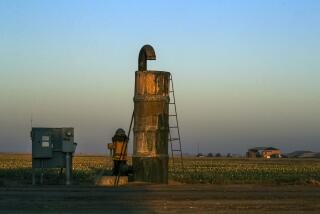Time to Pay for Clearing Channels
- Share via
The cranes and chain saws have removed the last shreds of vegetation from Medea Creek in Agoura Hills, and just a few water birds swim in the unshaded water.
Now, officials say, this creek and nearly 100 channels like it in Los Angeles County will flow as originally intended, guiding rainwater to the sea and away from the flood plains where homes are located.
It took public relations, heavy-handed politicking and more than a little scaremongering to win permission for the county to clear the channels, which had become clogged with plants and debris as local officials awaited regulatory permission to clear them out.
But even as county crews complete the last of their clearance work, their bosses must face the regulators again--along with environmentalists who are enraged that flood control workers were allowed to cut down willow trees and pull out native plants from the sandy-bottomed channels.
Two months ago, county public works officials accused the Army Corps of Engineers, which regulates activity in stream beds, of dragging its feet in approving permits that would allow the channels to be cleared. At that time, 47 of 95 channels designed to protect Los Angeles County residents from flooding had lost more than 35% of their capacity to brush and debris.
Under pressure, the corps and eight other regulatory agencies with jurisdiction over streams and channels agreed to speed up the process. But there were strings attached: The county had to agree in advance to pay for what environmentalists call mitigation--the replacement of the plants that were removed so that valuable habitat is not lost--even though the extent of the mitigation had not yet been decided.
So when county officials meet Tuesday with the corps and other regulators, including the U.S. Environmental Protection Agency and the California Department of Fish and Game, the issue will be how much the county will have to pay to mitigate the loss of the plant life, which regulators and environmentalists say provides valuable habitat for waterfowl and other animals.
Jim Noyes, chief deputy director of Public Works, said that in the worst-case scenario, the county could be required to spend $25 million on mitigation, building three new acres of wetland for every acre of habitat that was destroyed. That figure, he said, does not include the cost of acquiring land to build new wetlands.
Environmentalists, angered at what the county has called its “scorched earth” approach to some of the channels, have vowed to fight hard for the maximum mitigation.
“They should be held accountable for every tree that was taken out,” said Melanie Winter, managing director of Friends of the Los Angeles River.
“There is no proof,” Winter said, that native plants needed to be cleared along with intrusive exotics like arrundo, which choked many of the channels. “They had the resources to do those analyses, and they didn’t do them. And now it’s going to cost them.”
Although environmentalists have not been promised a seat at the negotiating table, Winter said her group is pressing hard to be included, and the EPA has asked that the concerns of environmentalists be taken into account by the corps, which will oversee the process.
Winter said her organization will push for replacement foliage along the banks of the rivers that were cleared. That way, animal life will not be forced to relocate and the appearance of the denuded channels will be improved.
But Noyes, who has said the county should not be forced to “write a blank check,” said officials will fight hard to keep the mitigation costs low.
“It’s going to be a negotiating effort between the county and the regulatory agencies and environmental interests,” Noyes said. “We’re going to put forth an honest mitigation effort, but the bottom line is very important to us. The environmentalists don’t have a bottom line--it’s not their money.”
Aaron Allen, the corps project manager who has been working with the county on the problem, said it’s too soon to know just how much mitigation will be required.
Some streams, like the San Gabriel River near Walnut Creek and Medea Creek in Agoura Hills, were swept clean by county crews.
“There was quite a bit of riparian habitat in the San Gabriel River,” Allen said. The exact amount of mitigation, he said, would depend on how long it took the county to replace the vegetation, and where the new greenery is planted.
Still, the overall cost will probably be less than originally anticipated, because of a push from county Supervisor Zev Yaroslavsky to abandon the “scorched earth” policy in many sensitive areas.
Because the county simply trimmed back vegetation in those spots, the cost of mitigation will not be as high.
“You get the same result from a flood control point of view, but you don’t destroy the habitat so you save money on mitigation,” Yaroslavsky said. “It’s a positive for the county and for the environment.”
Catherine Kuhlman, associate director of the water division of the EPA’s western division, said the agency is pleased so far with the approach taken by the county to clearing the channels.
But, she said, it is too soon to know whether there will be a rapprochement about mitigation.
“Once we hear what kind of a position they’re [county officials] going to take, we’ll know if we are going to have a cooperative dialogue or a combative dialogue,” Kuhlman asked. “It can be resolved quickly if the parties are willing to make some deals.”
More to Read
Sign up for Essential California
The most important California stories and recommendations in your inbox every morning.
You may occasionally receive promotional content from the Los Angeles Times.










